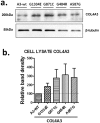Frequency of COL4A3/COL4A4 mutations amongst families segregating glomerular microscopic hematuria and evidence for activation of the unfolded protein response. Focal and segmental glomerulosclerosis is a frequent development during ageing
- PMID: 25514610
- PMCID: PMC4267773
- DOI: 10.1371/journal.pone.0115015
Frequency of COL4A3/COL4A4 mutations amongst families segregating glomerular microscopic hematuria and evidence for activation of the unfolded protein response. Focal and segmental glomerulosclerosis is a frequent development during ageing
Abstract
Familial glomerular hematuria(s) comprise a genetically heterogeneous group of conditions which include Alport Syndrome (AS) and thin basement membrane nephropathy (TBMN). Here we investigated 57 Greek-Cypriot families presenting glomerular microscopic hematuria (GMH), with or without proteinuria or chronic kidney function decline, but excluded classical AS. We specifically searched the COL4A3/A4 genes and identified 8 heterozygous mutations in 16 families (28,1%). Eight non-related families featured the founder mutation COL4A3-p.(G1334E). Renal biopsies from 8 patients showed TBMN and focal segmental glomerulosclerosis (FSGS). Ten patients (11.5%) reached end-stage kidney disease (ESKD) at ages ranging from 37-69-yo (mean 50,1-yo). Next generation sequencing of the patients who progressed to ESKD failed to reveal a second mutation in any of the COL4A3/A4/A5 genes, supporting that true heterozygosity for COL4A3/A4 mutations predisposes to CRF/ESKD. Although this could be viewed as a milder and late-onset form of autosomal dominant AS, we had no evidence of ultrastructural features or extrarenal manifestations that would justify this diagnosis. Functional studies in cultured podocytes transfected with wild type or mutant COL4A3 chains showed retention of mutant collagens and differential activation of the unfolded protein response (UPR) cascade. This signifies the potential role of the UPR cascade in modulating the final phenotype in patients with collagen IV nephropathies.
Conflict of interest statement
Figures




References
-
- Deltas C, Pierides A, Voskarides K (2013) Molecular genetics of familial hematuric diseases. Nephrol Dial Transplant. - PubMed
-
- LeBleu VS, Macdonald B, Kalluri R (2007) Structure and function of basement membranes. Exp Biol Med (Maywood) 232:1121–1129. - PubMed
-
- Van Agtmael T, Bruckner-Tuderman L (2010) Basement membranes and human disease. Cell Tissue Res 339:167–188. - PubMed
-
- Gubler MC (2008) Inherited diseases of the glomerular basement membrane. Nat Clin Pract Nephrol 4:24–37. - PubMed
Publication types
MeSH terms
Substances
LinkOut - more resources
Full Text Sources
Other Literature Sources
Research Materials

